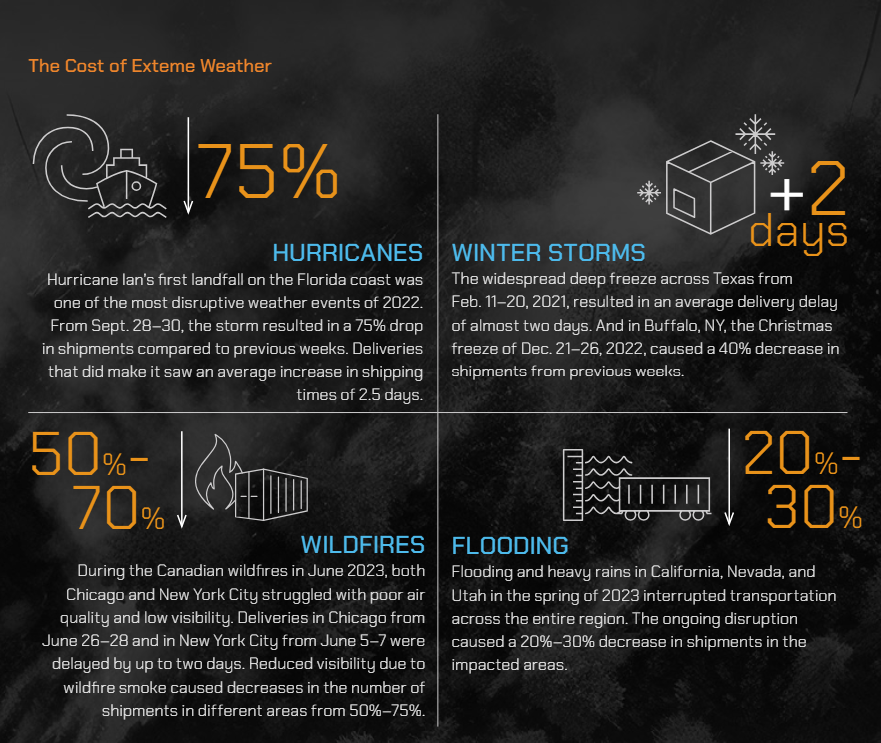Storm Season: What to expect and how to prepare
With an increase in extreme weather events predicted, industry professionals and drivers must prepare to protect their routes, assets, and safety. Here we highlight the importance of preparation and technology in navigating these challenging conditions.

By Emily Paul, for The Inside Lane
Severe weather conditions nationwide pose a risk to supply chains and assets, demanding preparation from industry professionals and drivers.
Hurricane season is underway, with the National Oceanic and Atmospheric Administration (NOAA) predicting an 85% chance of above-normal hurricane activity; meanwhile, tornadoes can occur at any time of year, though peak seasons vary by region.
Extreme weather events are expected to be the No.1 disruptor in supply chains this year and cost the U.S. approximately $1 billion every three weeks, according to research from Everstream Analytics, a trusted supply chain analytics company specializing in predictive insights and risk management.

What does this mean for the trucking industry? It’s time to prepare.
"Already, we are seeing storms move across the country that can bring additional hazards like tornadoes, flooding, and hail. Taking a proactive approach to our increasingly challenging climate landscape today can make a difference in how people can recover tomorrow," said Erik A. Hooks, deputy administrator of the Federal Emergency Management Agency (FEMA) at NOAA’s 2024 hurricane season press conference.
NOAA is predicting 17-25 named storms, 8-13 of those becoming hurricanes, and four to seven of those becoming major hurricanes over a Category 3 or higher.
The peak tornado season, according to NOAA, varies by region: it's from May to early June in the Southern Plains (Texas, Oklahoma, Kansas), earlier in the spring on the Gulf Coast, and in June or July in the Northern Plains and Upper Midwest (North and South Dakota, Nebraska, Iowa, Minnesota).
Both preparation and technology can be utilized to make the most of the routes and keep both drivers and cargo safe.
Preparation is paramount
When encountering less-than-ideal driving conditions, Clay Hamblen, safety director for Cypress Truck Lines in Jacksonville, Fla., says his drivers are all well-prepared for rough weather. His fleet predominantly serves the Southeast and Southwest and the safety department looks at the forecasts daily to ensure driver safety.
All drivers are prepared with clothes and food, but the biggest piece of advice Hamblen gives his drivers is to keep the truck fueled up.
“Make sure you don't run low on fuel so even if you do get stranded for a few days, then at least you can power the truck,” Hamblen told The Inside Lane. “We always tell our drivers ‘You’re the captain of the ship, so you have to use your best judgment.’”
Hamblen says that all Cypress drivers know to stay away from low-lying areas that may flood and to make sure their truck is in a safe place, such as a rest or truck stop, should they decide to pull over during rough weather.
With over 22 years of experience behind the wheel, Bob Bramwell of ABF Freight says that preparation for rough weather starts before he even gets in the truck. He monitors the weather forecasts in the morning before he leaves so he knows what he may run into on the drive. Bramwell said making sure he is well equipped for any condition, from freezing cold to torrential rain, is essential to his job.
“As professionals, we always make sure we maintain our equipment. Keeping the truck road-ready with extra supplies. It starts off there, pre-trip. If you find that something needs attention, like tires, windshield wipers or any fluids, address them,” Bramwell said. “As a driver, I carry blankets in the winter season and extra drinking water in the summer. I always make sure I have an emergency roadside kit to alert other motorists if I break down.”
Bramwell said he looks at weather apps and forecasts often on his route but also utilizes his fellow drivers for updates. He talks with other truckers going the opposite way via CB radio to ask about what he may be driving into.
Technology’s role in safety and efficiency during rough drives
Companies like WeatherOptics offer solutions for routing fleets through severe weather. Its RightRoute software can predict delay times, alternative routing options and road risk. Its artificial intelligence weather modeling improves forecast accuracy during severe weather by up to 50 percent, “which feeds into our suite of impact risk scores, intelligent routing, and hyperlocal weather products,” according to its website.
John Sutton, director of corporate strategy at Sunset Transportation, spoke recently in a virtual learning session with Transport Topics about how his company uses WeatherOptics to identify how a weather system can impact its routes and supply chains.
“We now have this sort of agent acting in the background proactively notifying us of any potential weather-related delays that our shipments may encounter and ultimately improving our service levels and allowing us to be more proactive than we have ever been with clients and carriers,” Sutton said.
Watch the weather and know what’s ahead
Maureen O’Leary, a spokesperson for the National Weather Service, told The Inside Lane they encourage the public to have multiple ways to get their weather information. She suggests having both a weather app from either a local TV/radio station or a national outlet.
NOAA also has its own weather radio broadcast that can be listened to on the road through a radio that can receive frequencies in the 162.40 to 162.55 MHz range. National Weather Radio broadcasts official weather warnings 365 days a year, and also includes warnings of natural disasters like earthquakes and avalanches.
Tornadoes are harder to predict, but O’Leary says NOAA typically has a lead time from eight to 18 minutes to warn those in the path of a tornado.
“The science behind understanding and detection capability of tornadoes is an active area of research we are pursuing as we work to improve the prediction and detection of hazardous weather,” O’Leary said. “Working with industry and academic researchers, we are making significant advancements in severe weather and flash flood modeling, which are expected to increase warning times for mesoscale events.”
Set yourself up for success and safety
Bramwell knows the dangers of extreme weather all too well. In 2007, he narrowly avoided an EF-5 tornado outside of Greensburg, Kan.
“The one I vividly remember, I was about an hour ahead of it. When I got to Wichita, I found out that a location I had stopped at for a break had just been wiped off the map,” Bramwell said. “Had it not been for being notified of what was coming, planning my route accordingly so I could keep moving, I could have very well been there when it struck.”
His best advice for drivers is to always be aware of what could be coming, and to stay prepared.
“Make a plan, know your surroundings, stay informed of the weather and know your route and what you may encounter and know the changes that may come based on the locations. Set yourself up for success.”
This topic was top of mind at Anderson Trucking Service in St. Cloud, Minn.. Safety Manager Michael Carlson’s recent blog post highlighted the dos and don’ts for truck drivers who face a tornado.
Do:
- Check the weather consistently
- Stop moving if a storm is approaching
- Take shelter in a ditch that’s free from debris, water or powerlines, and cover your head
- Stay in the truck and get away from the windshield if there are no other safe options
Don’t:
- Stop under an overpass
- Keep driving into the storm
“Always prioritize safety over timelines or pressures to keep moving during adverse weather conditions,” Carlson wrote.
“Taking shelter in a safe location, avoiding risky maneuvers, and staying informed about changing weather patterns are key strategies to protect yourself and your cargo.”
Have a question or comment about this article? Email Bianca Prieto at editor@theinsidelane.co
Not yet a subscriber to The Inside Lane newsletter? Join here.





Comments ()